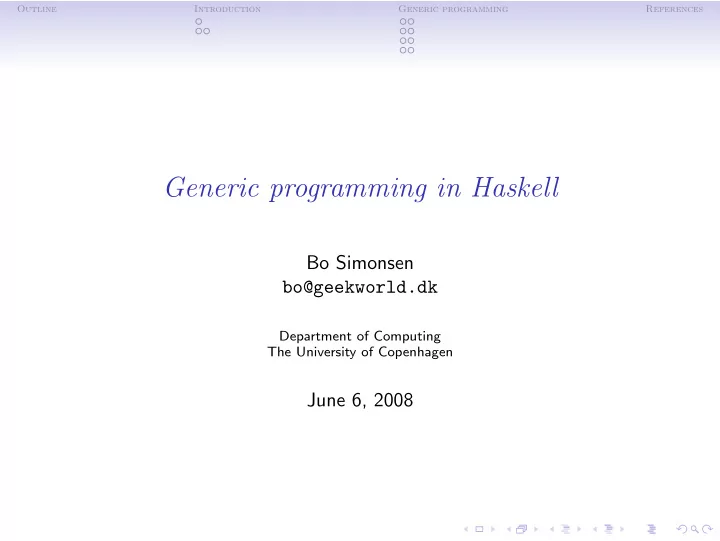

Outline Introduction Generic programming References Generic programming in Haskell Bo Simonsen bo@geekworld.dk Department of Computing The University of Copenhagen June 6, 2008
Outline Introduction Generic programming References Introduction What is haskell? Short introduction Generic programming Introduction Classes Inheritance An example: A binary tree References
Outline Introduction Generic programming References What is haskell? Haskell is a functional language. Some of the strengths are: • Lazy evaluation - makes infinite lists possible • Type classes • Monads • All you know from ML: Algebraic types, Pattern matching, Polymorphism
Outline Introduction Generic programming References A short introduction to haskell • Functions in haskell are defined using mathematical syntax e.g. Math: f : N → N f ( x ) = x 2 Haskell: f :: Int -> Int f x = x * x • Selection is done with guards (similar to the fork-notation in math): negate :: Bool -> Bool negate x | x == True = False | otherwise = True
Outline Introduction Generic programming References A short introduction to haskell II • Recursion is similar to ML: fib :: Int -> Int fib 0 = 1 fib 1 = 1 fib x = fib (x-1) + fib (x-2)
Outline Introduction Generic programming References Generic programming • Generic programming is an easy task. Simply replace the type with a lowercase letter e.g. ( { a , .., z } is often used) rev :: [a] -> [a] -> [a] rev [] y = y rev (x:xs) y = rev xs (x:y) This example works well but how about our first function? • We need to use: square :: Num a => a -> a square x = x * x • But why the ”Num a” part? Because the (*) operator/function requires it! But now the function works with floats, integers, ...
Outline Introduction Generic programming References Generic Programming II • A error occur if I try ’square ”abc”’ Main> square "abc" ERROR - Cannot infer instance *** Instance : Num [Char] *** Expression : square "abc"
Outline Introduction Generic programming References Classes in haskell Classes are a mixture of concepts and operator overloading in C++. • The num class: class (Eq a, Show a) => Num a where (+), (-), (*) :: a -> a -> a negate :: a -> a abs, signum :: a -> a fromInteger :: Integer -> a ... instance Num Int where ... • The class is defining properties and the instances is implementing them (default implementations are made in the class).
Outline Introduction Generic programming References Classes II • Other built-in classes: • Ord (ordering, less than, greater than, ..) • Eq (equality == / ¯ ) • Real • Integral (modulo operations) • Fractional (p/q) • Show (to string) • Floating (math functions like sin, cos, tan) • Functor • Enum (sequential ordering) • Bounded
Outline Introduction Generic programming References Inheritance • We will design a class, where we require the following for the input type • Ordering Ord • Equality Eq • Numeric Num • We will then program some functions which will be possible to use within this class scope. • The code on the next slide, is based on inheritance (Num and Ord inherits from Eq) and implement the described ideas.
Outline Introduction Generic programming References Inheritance II class (Num a, Ord a) => Myclass a where ds :: a -> a ds x | x < 5 = x + 5 | otherwise = x instance Myclass Int genInt :: Int genInt = 5 doSomething :: Myclass a => a -> a doSomething x = ds x
Outline Introduction Generic programming References An example: A binary tree With algebraic data types we can easily construct a data structure for a binary tree: data Tree a = NilT | Node a (Tree a) (Tree a) tmp = (Node 5 (Node 3 NilT NilT) (Node 7 NilT NilT)) Here I define the structure and make a simple tree containing 3,5,7. But how about printing it out? Without doing anything the interpreter gives us: Main> tmp ERROR - Cannot find "show" function for: *** Expression : tmp *** Of type : Tree Integer
Outline Introduction Generic programming References An example: A binary tree II As the error message said, we need to define an instance for the show class in order to print out the tree (This is equivalent to operator overloading in C++): instance Show a => Show (Tree a) where show (Node x l r) = show x ++ " " ++ show l ++ show r show (NilT) = "" Now I can simply write: Main> tmp 5 3 7
Outline Introduction Generic programming References Compilers/Interpreters & References Compilers / Interpreters • GHC - Glasgow Haskell Compiler Compiler and Interpreter http://www.haskell.org/ghc/ • Hugs Interpreter http://www.haskell.org/hugs/ References • Simon Thompson - Haskell: The Craft of Functional Programming - 2nd edition, ISBN: 0-201-34275-8, Pearson/Addinson-Wesley. • Richard Bird - Introduction to Functional Programming using Haskell - 2nd edition, ISBN: 0-13-484346-0, Pearson/Prentice Hall.
Recommend
More recommend